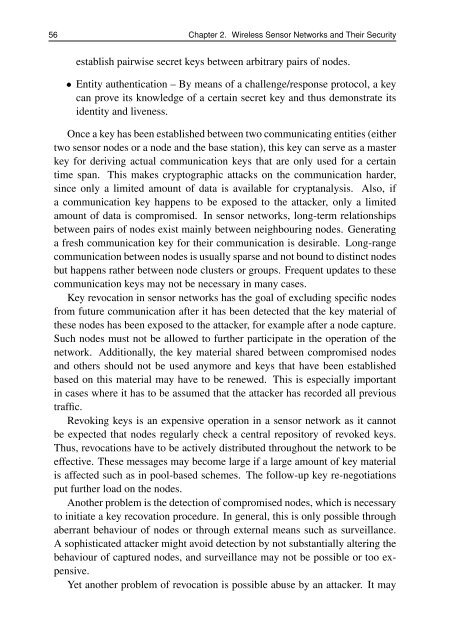Protocols for Secure Communication in Wireless Sensor Networks
Protocols for Secure Communication in Wireless Sensor Networks
Protocols for Secure Communication in Wireless Sensor Networks
Create successful ePaper yourself
Turn your PDF publications into a flip-book with our unique Google optimized e-Paper software.
56 Chapter 2. <strong>Wireless</strong> <strong>Sensor</strong> <strong>Networks</strong> and Their Security<br />
establish pairwise secret keys between arbitrary pairs of nodes.<br />
• Entity authentication – By means of a challenge/response protocol, a key<br />
can prove its knowledge of a certa<strong>in</strong> secret key and thus demonstrate its<br />
identity and liveness.<br />
Once a key has been established between two communicat<strong>in</strong>g entities (either<br />
two sensor nodes or a node and the base station), this key can serve as a master<br />
key <strong>for</strong> deriv<strong>in</strong>g actual communication keys that are only used <strong>for</strong> a certa<strong>in</strong><br />
time span. This makes cryptographic attacks on the communication harder,<br />
s<strong>in</strong>ce only a limited amount of data is available <strong>for</strong> cryptanalysis. Also, if<br />
a communication key happens to be exposed to the attacker, only a limited<br />
amount of data is compromised. In sensor networks, long-term relationships<br />
between pairs of nodes exist ma<strong>in</strong>ly between neighbour<strong>in</strong>g nodes. Generat<strong>in</strong>g<br />
a fresh communication key <strong>for</strong> their communication is desirable. Long-range<br />
communication between nodes is usually sparse and not bound to dist<strong>in</strong>ct nodes<br />
but happens rather between node clusters or groups. Frequent updates to these<br />
communication keys may not be necessary <strong>in</strong> many cases.<br />
Key revocation <strong>in</strong> sensor networks has the goal of exclud<strong>in</strong>g specific nodes<br />
from future communication after it has been detected that the key material of<br />
these nodes has been exposed to the attacker, <strong>for</strong> example after a node capture.<br />
Such nodes must not be allowed to further participate <strong>in</strong> the operation of the<br />
network. Additionally, the key material shared between compromised nodes<br />
and others should not be used anymore and keys that have been established<br />
based on this material may have to be renewed. This is especially important<br />
<strong>in</strong> cases where it has to be assumed that the attacker has recorded all previous<br />
traffic.<br />
Revok<strong>in</strong>g keys is an expensive operation <strong>in</strong> a sensor network as it cannot<br />
be expected that nodes regularly check a central repository of revoked keys.<br />
Thus, revocations have to be actively distributed throughout the network to be<br />
effective. These messages may become large if a large amount of key material<br />
is affected such as <strong>in</strong> pool-based schemes. The follow-up key re-negotiations<br />
put further load on the nodes.<br />
Another problem is the detection of compromised nodes, which is necessary<br />
to <strong>in</strong>itiate a key recovation procedure. In general, this is only possible through<br />
aberrant behaviour of nodes or through external means such as surveillance.<br />
A sophisticated attacker might avoid detection by not substantially alter<strong>in</strong>g the<br />
behaviour of captured nodes, and surveillance may not be possible or too expensive.<br />
Yet another problem of revocation is possible abuse by an attacker. It may
















